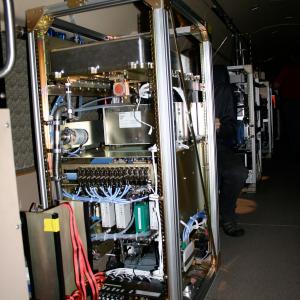Disclaimer: This material is being kept online for historical purposes. Though accurate at the time of publication, it is no longer being updated. The page may contain broken links or outdated information, and parts may not function in current web browsers. Visit https://espo.nasa.gov for information about our current projects.
Compact Atmospheric Multispecies Spectrometer (CAMS)
The CAMS instrument’s core design and operation is similar to the DFGAS (Difference Frequency Generation Absorption Spectrometer) instrument, which has been successfully deployed for fast, accurate, and sensitive airborne measurements of the important trace gas formaldehyde (CH2O). CAMS like DFGAS is based on tunable mid-IR (3.53-μm) absorption spectroscopy utilizing advanced fiber optically pumped difference-frequency generation (DFG) laser sources. Mid-Infrared light at 2831.6-cm-1 (3.53 μm) is generated by mixing two near-IR room temperature lasers (one at 1562 nm and the other at 1083 nm) in a non-linear crystal (periodically poled lithium niobate). The DFG laser output is directed through a multipass Herriott absorption cell (90-m pathlength in ~ 1.7 liter volume) where the laser light is selectively absorbed by a moderately strong and isolated vibrational-rotational absorption feature of CH2O. The transmitted light from the cell is directed onto an IR detector employing a number of optical elements. A portion of the IR beam is split off by a special beam splitter (BS) before the multipass cell and focused onto an Amplitude Modulation Detector (AMD) to capture and remove optical noise from various components in the difference frequency generation process. A third detection channel from light emanating out the back of the beam splitter is directed through a low pressure CH2O reference cell and onto a reference detector (RD) for locking the center of the wavelength scan to the absorption line center. The mid-IR DFG output is simultaneously scanned and modulated over the CH2O absorption feature, and the second harmonic signals at twice the modulation frequency from the 3 detectors are processed using a computer lock-in amplifier [Weibring et al., 2006].

